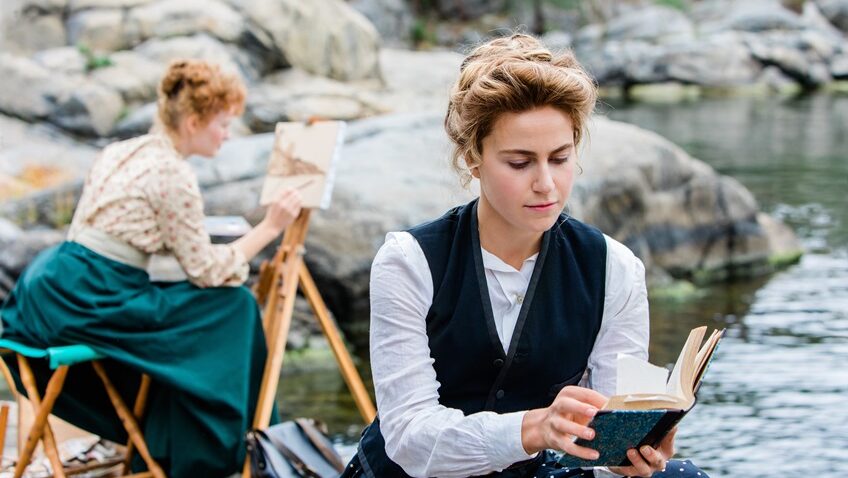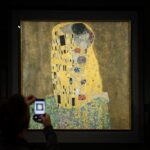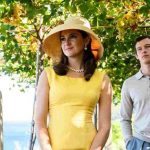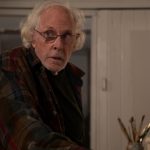Joyce Glasser reviews Hilma (October 28, 2022) Cert 12A, 119 mins.
Despite the early films, What’s Eating Gilbert Grape and Chocolat Lars Sven “Lasse” Hallström looked set to be remembered for his saccharine dog movies (Hachi: A Dog’s Tale, A Dog’s Purpose) and formulaic, melodramatic Nicholas Sparks weepies, Dear John and Safe Haven. At 76, the writer-director has thrown us a curve ball with Hilma, a good-looking and intelligent biopic of Hilma af Klint, the Swedish mystic and artist whose spectacular abstract compositions arguably pre-date Kandinsky, Malevich and fellow Theosophist, Piet Mondrian.
Such an innovative, enigmatic and even batty subject might call for a less conventional form of storytelling, however, and the repetitious séances and scenes of Impressionist-influenced plein air painting sessions grow tiresome. But as a Swedish director, Hallström clearly feels a responsibility to help us appreciate this unjustly overlooked Swedish artist. He not only shot Hilma in English for maximum exposure, but has turned the film into a family affair, successfully casting his daughter Tora Hallström and his wife Lena Olin as younger and older Hilma.
The prologue shows octogenarian Hilma af Klint (Olin), looking like a bag lady, facing rejection and ridicule by her brother who has no time for drawings and her babbling about a Temple. Flashback to happier times. It is 1880, when 18-year-old Hilma (Hallström) and her ten-year-old sister Hermina (Emmi Tiernstrom) are enjoying the beautiful, natural surroundings of their summer home on the island of Adelso – until Hilma assigns her sister a task in observation.
Hermina grows bored and wants to go home. ‘Scientists cannot just go home. We need to be patient,’ Hilma tells her, before pointing out a map of the islands made by their sea-faring grandfather. ‘We will make our own map one day,’ she promises Hermina. This sets the stage for the painter’s scientific approach to her paintings where she strives to show how all things in the world are connected. Many of her canvases resemble diagrams with symbols. When Hilma begins her “automatic” drawings in 1896, they cannot be shown before her research of the underlying map of the universe is completed or people would not understand them.
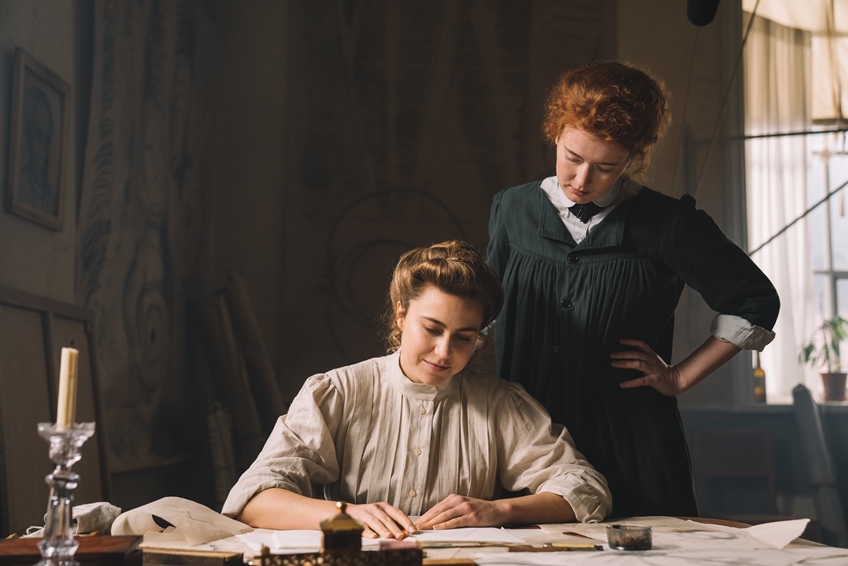
The tragic death of Hermina in 1880, has a long lasting impact on Hilma. Two years later and having been admitted to the Royal Academy of Fine Arts, Hilma finds herself caught up in the social life of Stockholm, including its fashionable interest in the occult, mysticism and Theosophy. Years later in a voiceover Hilma writes to her friend Anna Cassell (Catherine Chalk): ‘I keep working on that map of the world. My sister’s helping me.’
In the film Hilma attends an Edvard Munch exhibition and is moved to tears by his picture The Sick Child, showing his consumptive young sister in bed. ‘Don’t be sad,’ Munch tells her. ‘My sister is always with me. They all are with us.’ Like many at the time, Hilma turns to spiritualism to convince herself “there is no death.”
While women are welcome at the Royal Academy (Hilma would graduate with Honours), they have a separate entrance from the male students, and separate lessons. In her first lesson she meets Anna Cassel, a wealthy, single woman who shares Hilma’s interests and admires Hilma’s cheeky impertinence, for instance, painting the “truth” of the male anatomy behind the model’s loin cloth.
Experiencing af Klint’s art at the Serpentine Gallery’s exhibition in 2017, one could imagine a lonely, introverted and wacky matron, but in her twenties, Hilma was attractive, and socially and artistically engaged. She and Anna, who supports her financially, become lovers and Hilma compares their turbulent friendship to “a hook and an eye.” She ekes out a living painting traditional landscapes and portraits, painting outdoors with Anna in the manner of the Impressionists.
Through Anna, Hilma meets Mathilda Nilsson, the editor of a spiritualist magazine and her sister, Cornelia Cederberg (Rebecca Calder) who illustrates it. Together with Anna and Sigrid Hedman (Maeve Dermondy), the medium in their weekly séances, the women form a group known as The Five and document their progress in sketchbooks that reveal abstract symbols and patterns. Led by Hilma, the group sets out to conceptualise their spiritual messages through a geometric visual language that only Hilma really understands, in Paintings for the Temple. Her temple was never built, but she makes a pilgrimage to Rudolf Steiner’s temple in Dornach.
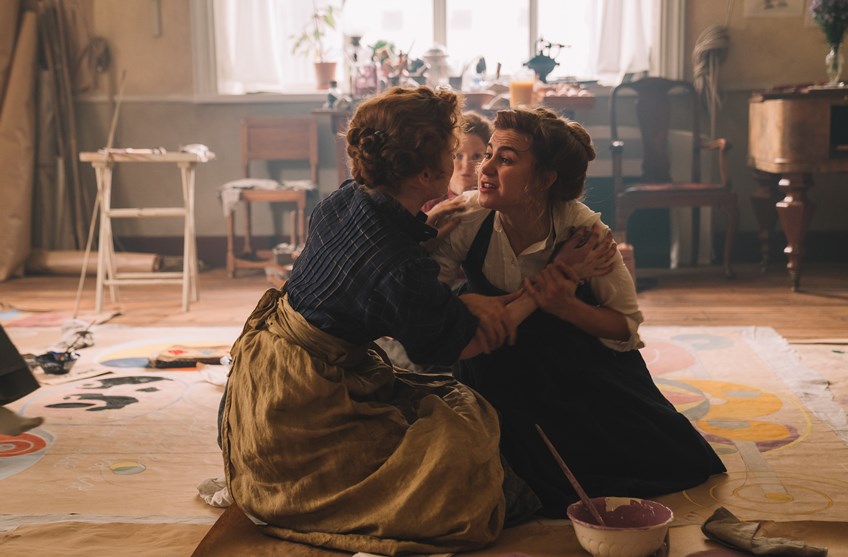
Hilma’s obsession was the brilliant academic, social reformer and philosopher Rudolf Steiner (Tom Wlaschiha) whose quest was to find a synthesis between science and spirituality. When Hilma goes to Stockholm to speak to Steiner, an exasperated Anna asks her why she is so obsessed with him. ‘He’s seen God and he knows the truth. And I have to find it,’ is Hilma’s reply.
Steiner professes to carry the knowledge of the spiritual world within himself and wrote, ‘‘I confirmed for myself by means of geometry the feeling that I must speak of a world ‘which is not seen’.’ Hilma has cause to believe ‘he’s like my soulmate.’ But if she goes through her adult life seeking his approval, she never finds it. He first rejects her because she claims The Great Masters lead her arm and she does their bidding. ‘When art doesn’t have its roots in the soul of the artist it does not interest me,’ Steiner declares. Hilma apparently stops painting for four years.
But when Steiner meets with her a second time to see her art, she has taken control of her brush. Now, Steiner feels if he does not understand her art, no one will, although Kandinsky’s abstracts are showing nearby. This rejection might explain Hilma’s reluctance to show her abstracts again. Her nephew inherits her estate and is instructed to keep the paintings hidden until twenty years after her death in 1944.
In a satisfying epilogue, we see both young and old Hilma looking out the window of the tram Hilma took on the last day of her life. But this time, they pass by the queues at the 2019 Guggenheim Museum exhibition Hilma af Klint: Paintings for the Future, reportedly the museum’s most successful exhibition since opening in 1952.
The strength of Hallström’s thoroughly researched film is that it places Hilma in the context of her times, a feat that not only makes her less eccentric than we might suspect, but that also highlights her individuality. What the film loses with this methodical and painstakingly accurate approach is not only drama, but the essence of the enigma of af Klint, that may never be cracked.

